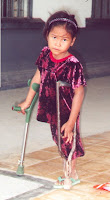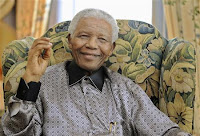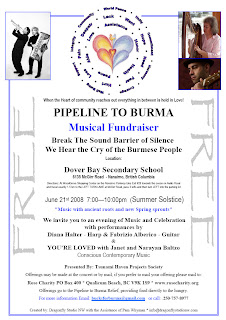
 RoseCharities Surgery
RoseCharities SurgeryRose Charities Rehabilitation Surgery - the '2TS' Principle Since 1997, Rose Charities has been promoting rehabiliation surgery in Cambodia and as a model for developing countries in general. This is a brief synopsis of the founding principles put into the Rose Charities Cambodian projects at that time by Will Grut. The Kien Khleang Center was identified at that time as being a suitable location for the project and Grut successfully obtained permission from the Ministry of Social action to open the Rose Charities Rehab Surgery center there. In 2002 after a horrendous robbery, looting and vandalization, the non ophthalmolgical part of the project was tranferred to Chea Chumneas Hospital and Operation FIRST established with Dr Nous Sarom to run it. This change has been most appropriate as the Kien Khleang Center, not being a proper hospital does not have proper facilities for responsible surgical procedures other than eye surgery (local anaesthetic, no risk of transfusion being necessary) and is not run by the Cambodian Ministry of Health. The following was written in 1997, but applies as much today as it did then in many countries in the developing world as well as to Cambodia
Rose Charities work with victims of land-mine and conflict injury, acid burns, cleft lip and palate, and other surgically treatable conditions ( meningoencephalocel , club foot, slow tumors , congenital malformations and many others ) is now well known all over Cambodia. Dr Nous Sarom , Operation FIRST with RoseCharities have been pivotal in this work and continue today increasing operation spectrum in areas such as micro-surgery , orthopedics, ear surgey etc, as well as training new surgeons, nursing and physical therapy staff . FIRST-Rose has an open door policy, welcoming bona fide students, residents, and other groups, local and international who genuinely and honestly wish to help the people and health system in Cambodia.
Conflict injury
Based in 1992 in Phnom Srouch, a heavily landmined and conflict infected area of Cambodia, Dr.William Grut observed that conflict health problems fell into one or more of three categories
Primary conflict injury / disability : Injury resulting directly from the conflict. Amputees, other land mine injuries, bullet wounds etc.
Secondary conflict injury / disability: Injury, as a result of the disruption of infrastructure of the county. Thus, elimination or serious reduction in health services, and / or access to those services or clinics. Lack of education. Lack of vaccination programs. Lack of health surveillance. Dangerous transport methods over destroyed roads, bridges etc. Polio, post meningitis, cerebral malaria handicaps, effects of measles, shistosomiasis etc.
Tertiary conflict injury / disability. Injury / disability caused by the 'physical conflict mindset' which sees the solution to any problem as being the use of physical violence. Thus, deliberately inflicted acid burns, beatings and other physical cruelty. Forceful control, rape etc. Tertiary conflict problems can be very much accentuated by secondary conflict effects such as the lack of a fair and functioning judicial system and / or corruption in the law enforcement services.
The Rose Charities '2TS' rehabilitation surgery concept
The focus of the Rose rehab surgery model is aimed entirely at two aspects . .. 1) an improvement in quality of life for the sufferer of the disability.... and..... 2) the ability of the country or region to sustain facilities which will lead to such improvements for future suffers.
This is achieved by the paradigm called by Rose '2TS' which stands for ... 'Treatment sustainability & Training Support' ..... and in its most basic form it is this which was defined as the basis of the Rose model based on the following observations, practical experience, and summation, below...
Treatment sustainablity
To be sustainable, health services in any country must be at a cost consistent with what a country can afford and give maximum benefit for the money spent. Since the 1970s the formula to achieve this has focused more on 'Primary Health Care (PHC), elements of vaccinations, mother and child health, sanitation, clean water, education and basic treatment of the most prevalent diseases in the community. PHC continues to give enormous benefits to the health of populations when administered properly. It thus must always be in the front line of the health improvement processes in developing countries.
Due perhaps to the success of PHC however there has sometimes been a tendency to see it as the only health process which can be sustainably implemented at acceptable cost. Surgery, on the other hand is seen as expensive, non cost effective, far to complex and sophisticated and needing inappropriately large resources to sustain a trained level of human resources.
The 'Rose model' however shows both theoretically and (by the work of Rose Charities , www.RoseCharities.org ) and in practice, that surgery too can be cheap, effective in the improvement of quality of life, sustainable, safe and highly desirable.
The Rose model is based on the observations..
Rehab surgical procedures, carried out properly in developing countries by locally trained surgeons can have costs per procedure well equivalent or less than the cost of many of the longer term drug treatments (i.e. for TB, Leprosy etc. etc). Thus a cataract operation which will restore sight to a blind person can cost as little as USD 17 (Rose Charities Cambodia figures for 2005), or a cleft lip or palate, land mine amputation etc, USD 30 - 50)
Rehab surgical procedures often have an enormous benefit, not only for the sufferer of the disability but also for her / his family, village, community. A child who has had a cleft lip or palate repaired is no longer considered 'an idiot'; he/she can go to school, get married, be employed etc. Rehab surgery thus can significantly increase the D.A.L.Y. (Disability adjusted life years ) of an individual, community or even, with nation programs, the whole country.
Populations WANT rehab. surgery. People, wherever they are, want to be cured of or at least helped with their disabilities. If you ask a group of villagers in almost any community whether they would like a clean well, instead of the old muddy stream that they and their animals may be drinking from OR sigh restored to their parents, or their children's cleft lips repaired, or their men to get proper surgical assistance to get a an artificial limb, they will invariably choose the latter. This is not an incitement on PHC, simply a statement of the fact that it is the quality of life perceived by the community itself which should be taken into primary consideration and not just the perceptions of the planners. (who, far more often than not, are not those who live in the villages where the assistance is being made.
Training support.
Support for training - the implementation of cost effective training programs is the crucial element in ensuring treatment sustainablity above. Dr. Grut realized that appropriate training programs....
Need not be expensive. They can be implmentable with the assistance of relatively small international funding agencies and/or national resources. Resources for training can be left within the country in the form of upgrades to existing facilities and or equipment donations
Already have the the basic human resources in place i.e. already qualified physicians, anaesthetic nurses, even nurse-practitioners in outlying areas already in place and interacting with the population in need.
Can be implemented by volunteers from the industrialized or other countries by multiple short term voluntary visits. This has the multiple effects of giving the international trainer a fascinating and enormously appreciated new facet to her / his vocation, making new friendships, linking the trainees into an international network, as well as the main goal of improving health care in the developing country.
Can be linked into a region or nation wide network
Have a multiplying effect, in that once trained, the recipients of training can go out and train others...
Can be linked and integrated with PHC individual or team training to provide the most comprehensive health care 'package' for the country.





